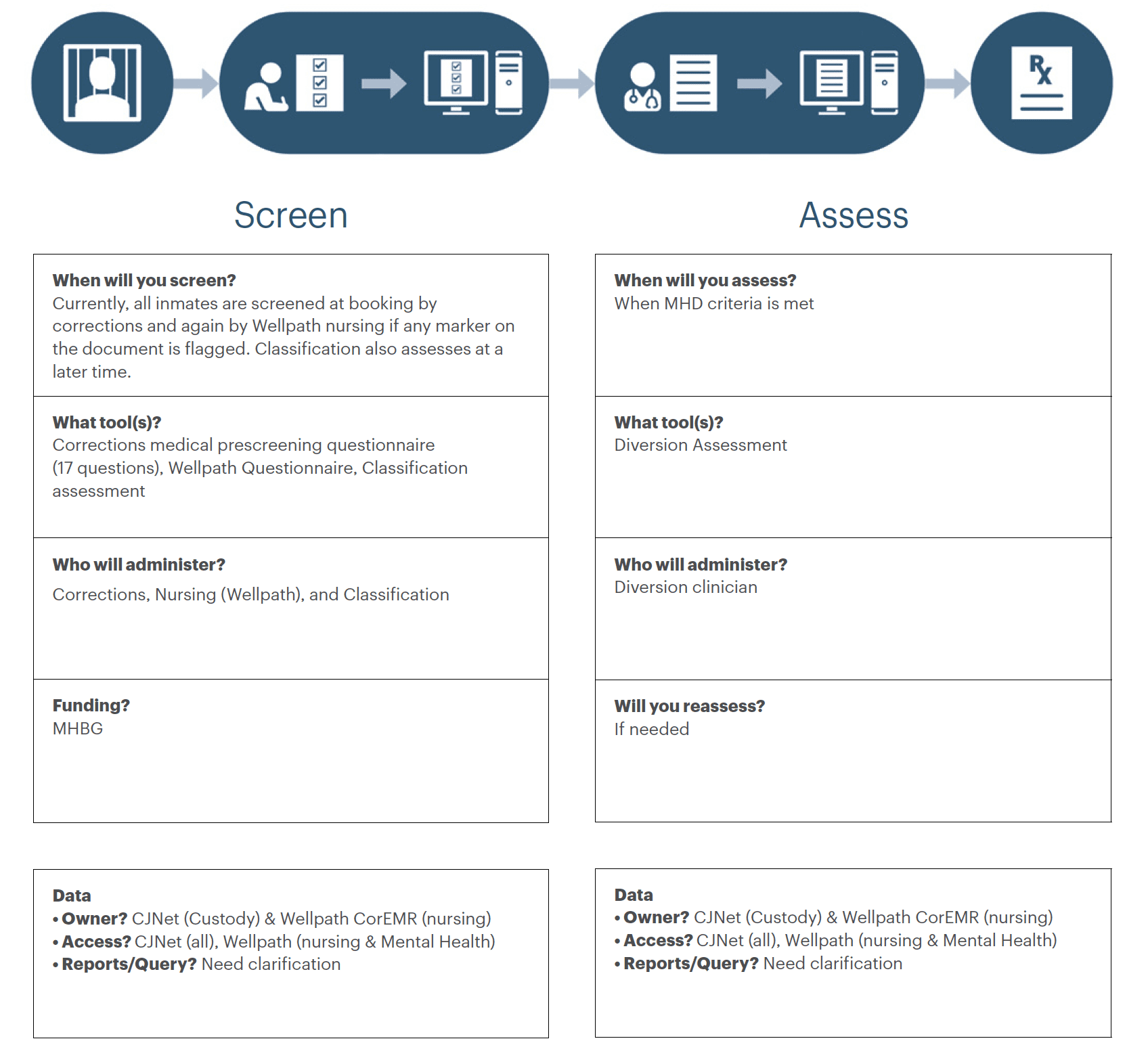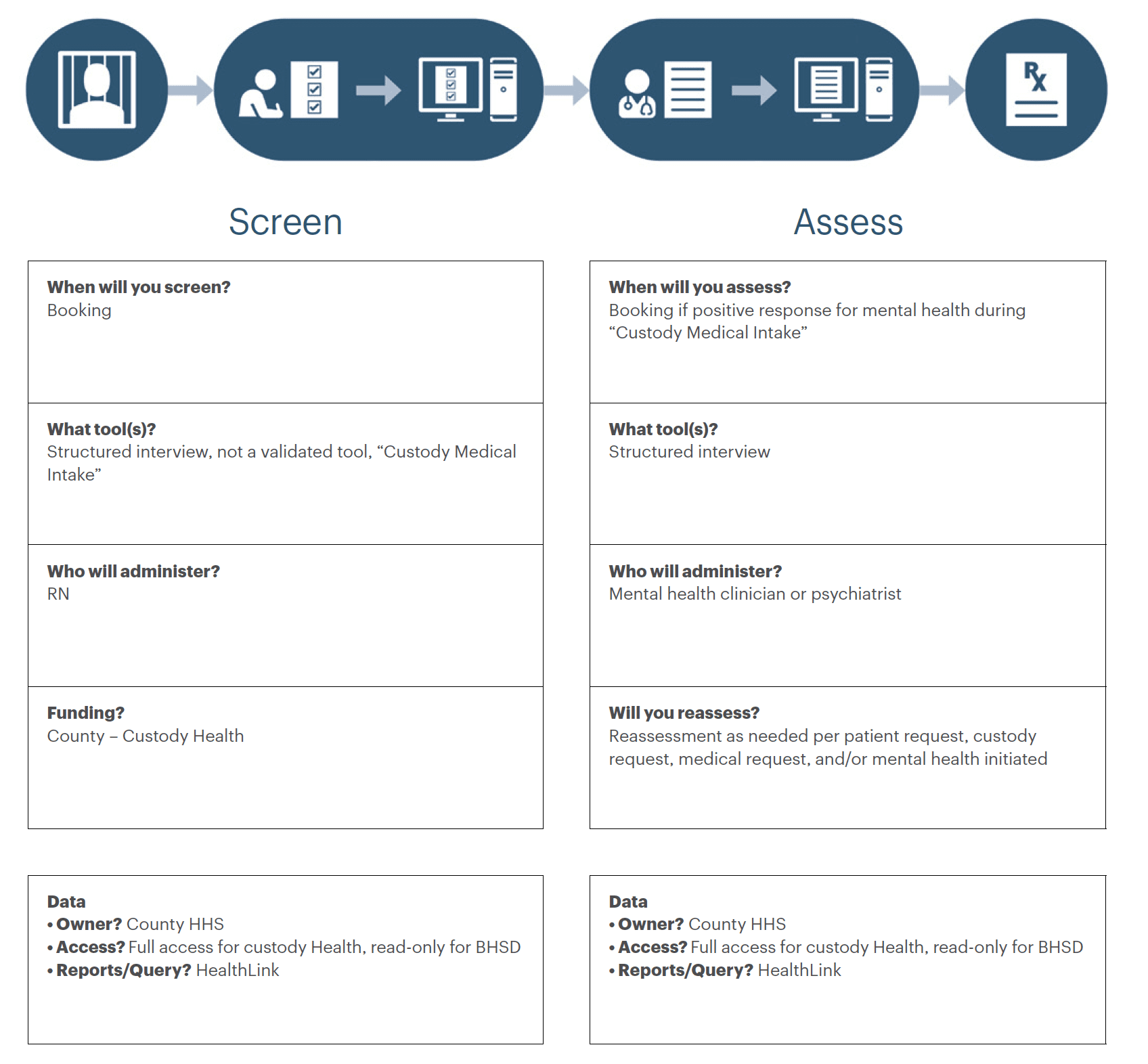Screening and Assessment for Behavioral Health Needs in California Jails Workshop Manual
Screening and Assessment for Behavioral Health Needs in California Jails Workshop Manual
The Council of State Governments (CSG) Justice Center partnered with California’s Mental Health Services Oversight and Accountability Commission in the spring of 2021 to provide a series of four virtual workshops on mental health screening and assessments in jails as part of Stepping Up California’s work to help counties reduce the number of people with behavioral health needs in jail. The workshops were designed for interdisciplinary county teams, including representatives from jail (both management and booking), jail mental health providers, and county behavioral health. The first seven county teams who registered for the training were selected to participate: Santa Barbara, Napa, Modoc, Santa Clara, Kern, Siskiyou, and Contra Costa. Sixty individuals registered for the training series.
Each training session included presentations by CSG Justice Center staff and a review of resources, including the SAMHSA Screening and Assessment of Co-Occurring Disorders in the Justice System workbook, the Stepping Up brief Implementing Mental Health Screening and Assessment, and academic articles related to the validity and research behind some of the different screening tools. The sessions also included presentations from representatives from San Luis Obispo, Riverside, Imperial, and San Joaquin counties about their screening and assessment processes. San Joaquin and San Luis Obispo counties have both been recognized as Stepping Up Innovators. The additional speakers were selected to diversify the geographies and perspectives represented.
Participants in the training series learned to recognize the importance of completing universal screenings and follow-up assessments and learned about different examples of screening tools and some of their limitations. The facilitators and training panelists also reinforced the need to conduct screening and assessment using a person-centered and trauma-informed lens. The importance of communication and collaboration between custody, behavioral health, and community behavioral health staff was another key takeaway of the training series.
How to Use This Manual
This manual was created for the workshop series to help participants develop, organize, and centralize their jail screening and assessment processes in one document, consider where changes need to be made, and develop next steps for improving the screening and assessment processes. The manual can be used by anyone interested in improving jail screening and assessment processes, regardless of participation in the workshop series. For instance, jail (management and booking) and behavioral health staff, both in the jail and in the community may wish to use the manual to help facilitate collaboration and communication between these groups. The manual can be used during in-person planning meetings or individually by staff.
Session 1: Identify Goals and Tools for Behavioral Health Screening
-
Describe your current behavioral health screening process: (Note that screening for suicide risk alone will not flag indicators of potential mental illness and vice versa.)
-
Review the recommended validated behavioral health screening tools below. Which of these tools does your interdisciplinary county team plan to implement

-
Why did your team choose these tools?
Session 2: Planning Screening Processes and Establishing a Shared Definition of Serious Mental Illness (SMI)
-
Whom do you plan to screen and at what times?
-
Who will administer the screening tools?
-
What costs are associated with implementing screening? How might you cover these costs?
-
How will you track and store the data on how many people are screened? Do you anticipate including permissions/authorizations to share this information?
-
Who will have access to this data?
-
Will your database provide reports, allow for queries, or both?
-
What are the definitions of mental illness and SMI that your planning team has decided to adopt?*
*Feel free to use the California-specific Model Shared Definition, which cites California’s welfare and Institutions Code (WIC) §5600.3(b).
Session 3: Going from Screening to Assessment
-
Use the following questions to describe the mental illness/substance use needs assessment process that your team has decided to adopt:
- What will trigger an assessment by a clinician?
- When will you assess people who are flagged by the screening tools?
- What assessment tool(s) will be administered? Who will administer the tool(s)?
- Is periodic reassessment of the tool required?
- Yes (How often and by whom?)
- No (Why not?)
-
How will you track and store the mental illness/substance use assessment data?
-
Who will have access to this data?
-
Will your database provide reports, allow for queries, or both?
Session 4: Addressing Implementation Barriers
-
What main challenges has your group identified with implementing screening and assessment for mental illness/substance use for people in your jail?
-
List the action steps for addressing these barriers. Who can support your efforts?
The graphic below can be used to capture a snapshot of a jail’s screening and assessment process. Each question can be answered with a few words, and the graphic can be shared with other staff working in the jail and/or community mental health provider staff. The graphic can also be easily updated if changes are made to the screening or assessment processes. The graphics on pages 5–7 were completed by some of the counties that participated in the screening and assessment workshop series and can be used as guides when completing your own jail screening and assessment process diagram. 
Example: Napa
Definition of SMI: Local Shared Definition

Example: Santa Clara
Definition of SMI: Local Shared Definition
Example: Siskiyou
Definition of SMI: Local Shared Definition












